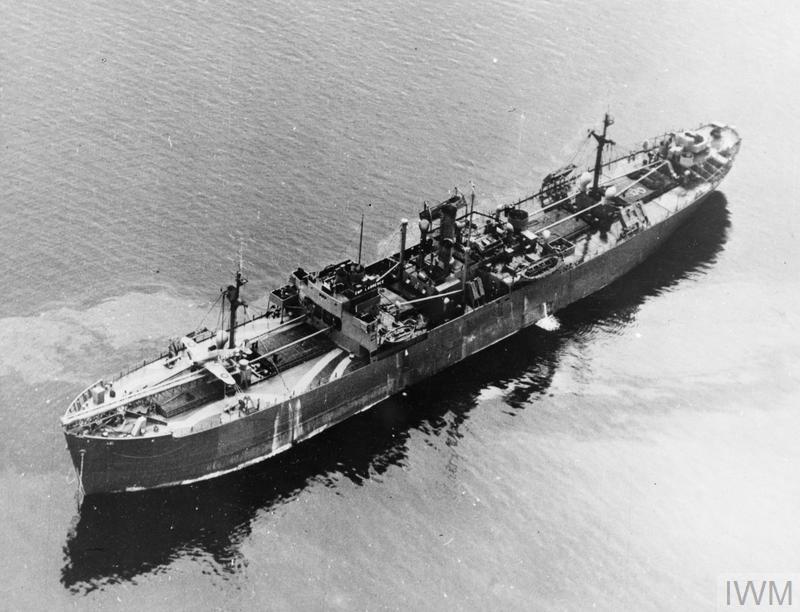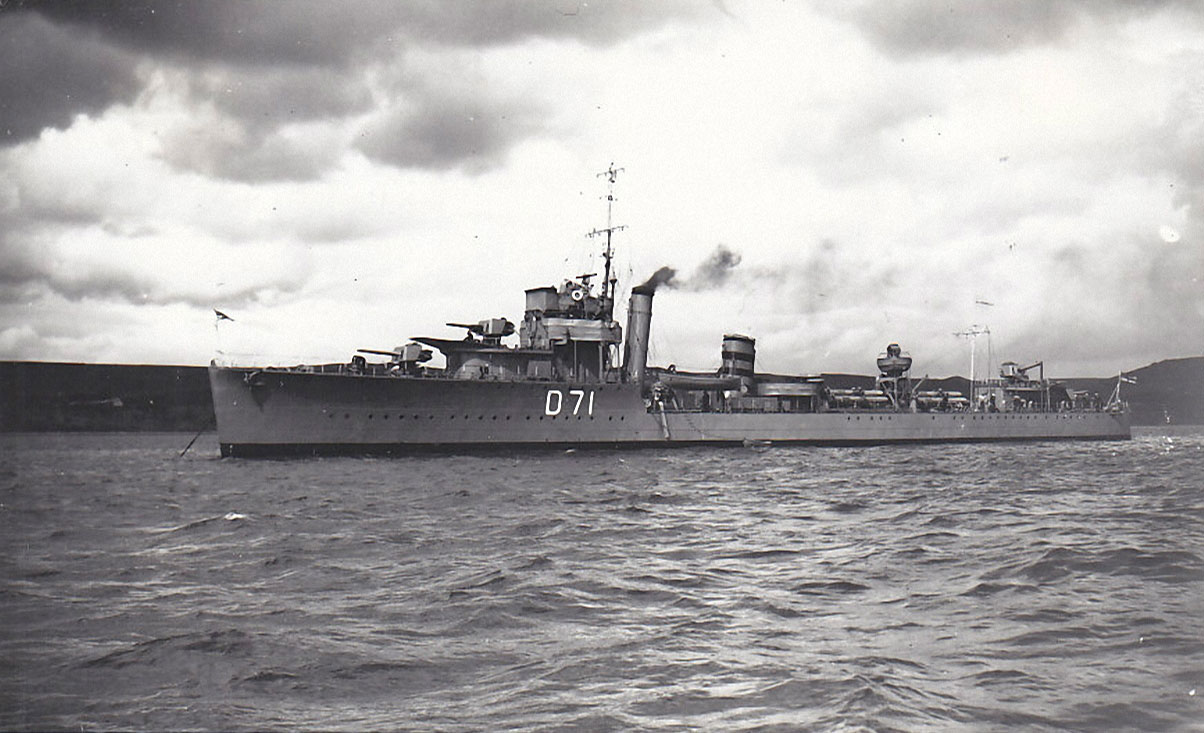Arctic Convoy PQ.16
The sinking of the CAM Ship Empire Lawrence
and the rescue of the CAM Pilot by HMS Volunteer
In May 1942 the Volunteer was
part of the escort of the Russian Convoy PQ.16 to Murmansk on the Kola Inlet. The convoy was
continuously shadowed by enemy aircraft in the early stages and later
heavily attacked by torpedo aircraft and bombers. Several U-boats
joined in the attack. Seven of the thirty-four ships in the convoy were
lost and four damaged and the Polish destroyer Garland
severely damaged, but on 30 May the convoy passed Toros Island at the entrance to the Kola Inlet,
'reduced in numbers, battered and tired, but still keeping perfect
station', in the words of the Commanding Officer, HMS Ashanti.
Alexander Rothney, a Radio Officer in the merchant ship, SS Atlantic, gives a vivid description of this convoy on the BBC Peoples War website but fails to mention the shooting down of the CAM Pilot launched by the CAM Ship Empire Lawrence and his rescue by HMS Volunteer.

The Catapult Aircraft Merchant ship (CAM Ship) Empire Lawrence with its Huricat in launch position on the bow
Crown Copyright IWM FL 11425
*************
Lt. Arthur Shubrook Pomeroy, the CO of the
Volunteer, describes the rescue of his fellow South African, Alastair Hay:
“Let me tell you how I met a fellow
South African in the Arctic. Our station was on the port bow of the
leading ship of the port column, the Empire Lawrence
which was fully loaded with explosives and ammunition. Mounted on her
forecastle was a catapult with a Hurricane fighter aircraft piloted by
Alastair Hay. On the first day of intense bombing, he was shot off into
the air to engage single-handed the squadrons of Heinkel III and
Junkers 88s.
Eventually, wounded, he had to bale out, as there was no carrier to
land on. I lowered a boat to pick him up, and just as the boat’s falls
were hooked on again for hoisting, two torpedo-bombers came at us low
down from the North. With the boat still only a few inches out of the
water and my hair standing on end, I ordered Full Ahead and
Hard-a-Starboard to steady course to comb the tracks of the torpedoes,
which we could see, one on each quarter.
This took us on an exact collision course with the Empire Lawrence.
There was just time to alter to port ahead of the port torpedo, and
then both of them struck her and she disintegrated in an immense
explosion, just a grating and a few bits of wood left floating”
Alastair Hay was exceptionally lucky. The chance of surviving after
parachuting into Arctic waters were always low but in his case he was
pulled aboard HMS
Volunteer minutes before the torpedoes aimed at her sunk the
Empire Lawrence. John Kennedy, the pilot of the Hurricat on the
Empire Morn,
the CAM-ship which escorted the PQ.15 died from exposure after his
recue.
There were 35 CAM-ships and they were credited with seven kills. The
planes and their pilots were providerd by the Merchant Ship Fighter
Unit (MSFU) an RAF unit based at RAF Speke, in south Liverpool, now
Liverpool John Lennon Airport The CAM-ships were the only means of
providing fighter
protection until the introduction of the "Woolworth Carriers",
converted merchant ships with a landing deck.
Reginald Walker, a DEMS (Defensively equipped merchant ship) rating on the
Empire Lawrence when she was sunk on 27 May 1942, describes his rescue by HMS
Hyderabad and
the four months he spent in Russia on Reels 1 and 2 of a recorded
interview in the Sound Collection at the IWM which can be heard online.
And Anthony Rothney, a Radio Officer in the merchant ship, SS
Atlantic, described how the officers in the merchant ships agreed
to accomodate the survivors from the seven ships lost including the
CAM-ship:
"We were all aware that survivors from
the section of the convoy that had succumbed to attack were having a
pretty rough time of it. Billeted in a ramshackle camp further down the
inlet, nobody seemed to know what to do about them. With this in mind,
our chief officer called all the other officers into the saloon. His
proposal was that each of us might share our cabin with a surviving
fellow officer. There was the facility to do this with each cabin
furnished with a full-length settee as well as a bunk. Accommodation
for other ranks was to be provided in an upper hold; army gunners were
already thus accommodated.
The scheme was adopted, and survivors were distributed among the
various ships. We three radio officers were joined by the three fellow
officers from the CAM-ship Empire Lawrence.
All of them insisted on sharing our duties. I had started the voyage
with one assistant. Now I had five. On cargo ships, which in peace time
only had one radio officer, it was usual to have the radio officer's
cabin next to the radio office or at least accessed through it. The SS Atlantic
was different, in that everyone had to go through my cabin to get to
the radio office. With one lodger and four radio officers constantly
passing through, as well as the odd visitor, I sometimes felt I was
camping in a corridor. That didn't worry me. Still a teenager, like all
the other radio officers except one, I had the optimism and resilience
of youth."
On 27 June, four weeks after our arrival, we left Murmansk in convoy
QP13. At the same time, the next supply convoy, PQ17, left Iceland for
Archangel. The following day we met up with the PQ16 ships that had
gone to Archangel, plus some that had been frozen in there all winter.
We were soon spotted by a German plane, though no attacks followed. On
2 July we passed PQ17.
The following day we split up, and, with 18
other ships, headed for Loch Ewe. The rest of the ships headed for
Iceland. At Loch Ewe all the survivors we’d accommodated were taken
ashore, and we docked finally at Leith to discharge our cargo. We were
fully expecting to go back to Russia, but, instead, we were despatched
to Philadelphia, USA, because the Russian convoys had been cancelled.
It was only later that I heard of the disaster that had befallen PQ17.
The Germans, it seemed, had preferred to concentrate their fire on
them.
The
Volunteer was one of five
destroyers included in the escort of
the return convoy QP.13 which after an
uneventful passage divided off the north-east coast of Iceland on 4
July. The
Volunteer parted
company in the vicinity of Bear Island to proceed to Rosyth for a
refit, on the 6 July, but the other part of the convoy ran into a
British minefield in thick fog, and four merchant ships and the
minesweeper
Niger were lost.
When Arctic Convoys
resumed in September after the disasterous losses experienced on PQ.17
they were accompanied by Escort Carriers which for the first time gave
adequate protection against attacks from the air and could spot u-boats
and sometimes sink them or, at least, make them keep their heads down.

 HMS VOLUNTEER
HMS VOLUNTEER
